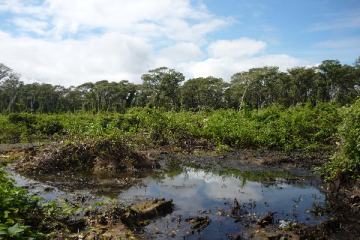A review of green- and blue-water resources and their trade-offs for future agricultural production in the Amazon Basin: what could irrigated agriculture mean for Amazonia?
1Institute for Resources, Environment and Sustainability, University of British Columbia, 2202, Main Mall, Vancouver, B.C., V6T 1Z4, Canada
2Woods Hole Research Center, 149 Woods Hole Road, Falmouth, MA 02540-1644, USA
3Department of Earth, Ocean and Atmospheric Sciences, University of British Columbia, 2207, Main Mall, Vancouver, B.C., V6T 1Z4, Canada
2Woods Hole Research Center, 149 Woods Hole Road, Falmouth, MA 02540-1644, USA
3Department of Earth, Ocean and Atmospheric Sciences, University of British Columbia, 2207, Main Mall, Vancouver, B.C., V6T 1Z4, Canada
Abstract: The Amazon Basin is a region of global importance for the carbon and hydrological cycles, a biodiversity hotspot, and a potential centre for future economic development. The region is also a major source of water vapour recycled into continental precipitation through evapotranspiration processes. This review applies an ecohydrological approach to Amazonia’s water cycle by looking at contributions of water resources in the context of future agricultural production. At present, agriculture in the region is primarily rain-fed and relies almost exclusively on green-water resources (soil moisture regenerated by precipitation). Future agricultural development, however, will likely follow pathways that include irrigation from blue-water sources (surface water and groundwater) as insurance from variability in precipitation. In this review, we first provide an updated summary of the green–blue ecohydrological framework before describing past trends in Amazonia’s water resources within the context of land use and land cover change. We then describe green- and blue-water trade-offs in light of future agricultural production and potential irrigation to assess costs and benefits to terrestrial ecosystems, particularly land and biodiversity protection, and regional precipitation recycling. Management of green water is needed, particularly at the agricultural frontier located in the headwaters of major tributaries to the Amazon River, and home to key downstream blue-water users and ecosystem services, including domestic and industrial users, as well as aquatic ecosystems.
Click here to download the publication.

Photo credit: Michael J. Lathuillière